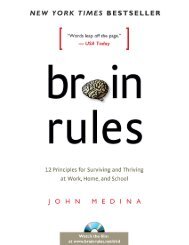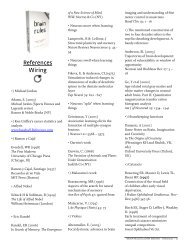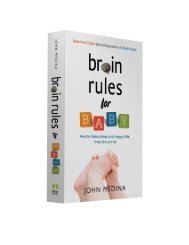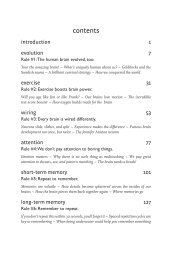Create successful ePaper yourself
Turn your PDF publications into a flip-book with our unique Google optimized e-Paper software.
ExerciseRule #1Exercise boosts brain power.Our brains were built for walking—12 miles a day!To improve your thinking skills, move.Exercise gets blood to your brain, bringing it glucose for energy andoxygen to soak up the toxic electrons that are left over. It alsostimulates the protein that keeps neurons connecting.Aerobic exercise just twice a week halves your risk of dementia.
SurvivalRule #2The human brain evolved, too.We don't have one brain in our head—we have three. We startedwith a “lizard brain” to keep us breathing, then added a brain like acat’s, and then topped those with the thin layer of Jell-O known asthe cortex—the third, and powerful, “human” brain.We took over the Earth by becoming adaptable to change, comingdown from the trees to the savannah when the climate changed.Going from four legs to two to walk on the savannah freed upenergy to develop a complex brain.Symbolic reasoning—the ability to perceive one thing as another—is a uniquely human talent. It may have arisen from our need tounderstand one another’s intentions and motivations, allowing us tocoordinate within a group.
WiringRule #3Every brain is wired differently.What you do and learn in life physically changes what your brainlooks like—it literally rewires it.The various regions of the brain develop at different rates indifferent people.No two people’s brains store the same information in the same wayin the same place.We have a great number of ways of being intelligent, many of whichdon’t show up on IQ tests.
AttentionRule #4People don’t pay attentionto boring things.The brain’s attentional “spotlight” can focus on only one thing at atime: no multitasking.We are better at seeing patterns and abstracting the meaning of anevent than we are at recording detail.Emotional arousal helps the brain learn.Audiences check out after 10 minutes, but you can keep grabbingthem back by telling narratives or creating events rich in emotion.
Short-term memoryRule #5Repeat to remember.The brain has many types of memory systems. One type followsfour stages of processing: encoding, storing, retrieving, andforgetting.Information coming into your brain is immediately split intofragments that are sent to different regions of the cortex forstorage.Most of the events that predict whether something learned also willbe remembered occur in the first few seconds of learning. The moreelaborately we encode a memory during its initial moments, thestronger it will be.You can improve your chances of remembering something if youreproduce the environment in which you first put it into your brain.
Long-term memoryRule #6Remember to repeat.Most memories disappear within minutes, but those that survive thefragile period strengthen with time.Long-term memories are formed in a two-way conversationbetween the hippocampus and the cortex, until the hippocampusbreaks the connection and the memory is fixed in the cortex—which can take years.Our brains give us only an approximate view of reality, because theymix new knowledge with past memories and store them togetheras one.The way to make long-term memory more reliable is toincorporate new information gradually and repeat it in timedintervals.
SleepRule #7Sleep well, think well.The brain is in a constant state of tension between cells andchemicals that try to put you to sleep and cells and chemicals thattry to keep you awake.The neurons of your brain show vigorous rhythmical activity whenyou’re asleep—perhaps replaying what you learned that day.People vary in how much sleep they need and when they prefer toget it, but the biological drive for an afternoon nap is universal.Loss of sleep hurts attention, executive function, working memory,mood, quantitative skills, logical reasoning, and even motordexterity.
StressRule #8Stressed brains do not learnthe same way as non-stressed brains.Your body’s defense system—the release of adrenaline andcortisol—is built for an immediate response to a serious but passingdanger, such as a saber-toothed tiger. Chronic stress, such ashostility at home, dangerously deregulates a system built only todeal with short-term responses.Under chronic stress, adrenaline creates scars in your blood vesselsthat can cause a heart attack or stroke, and cortisol damages thecells of the hippocampus, crippling your ability to learn andremember.Individually, the worst kind of stress is the feeling that you have nocontrol over the problem—you are helpless.Emotional stress has huge impacts across society, on children’sability to learn in school and on employees’ productivity at work.
Sensory integrationRule #9Stimulate more of the sensesat the same time.We absorb information about an event through our senses,translate it into electrical signals (some for sight, others from sound,etc.), disperse those signals to separate parts of the brain, thenreconstruct what happened, eventually perceiving the event as awhole.The brain seems to rely partly on past experience in deciding howto combine these signals, so two people can perceive the sameevent very differently.Our senses evolved to work together—vision influencing hearing,for example—which means that we learn best if we stimulateseveral senses at once.Smells have an unusual power to bring back memories, maybebecause smell signals bypass the thalamus and head straight to theirdestinations, which include that supervisor of emotions known asthe amygdala.
GenderRule #11Male and female brains are different.The X chromosome that males have one of and females have twoof—though one acts as a backup—is a cognitive “hot spot,” carryingan unusually large percentage of genes involved in brainmanufacture.Women are genetically more complex, because the active Xchromosomes in their cells are a mix of Mom’s and Dad’s. Men’s Xchromosomes all come from Mom, and their Y chromosomecarries less than 100 genes, compared with about 1,500 for the Xchromosome.Men’s and women’s brains are different structurally andbiochemically—men have a bigger amygdala and produce serotoninfaster, for example—but we don’t know if those differences havesignificance.Men and women respond differently to acute stress: Womenactivate the left hemisphere’s amygdala and remember theemotional details. Men use the right amygdala and get the gist.
ExplorationRule #12We are powerful and natural explorers.Babies are the model of how we learn—not by passive reaction tothe environment but by active testing through observation,hypothesis, experiment, and conclusion.Specific parts of the brain allow this scientific approach. The rightprefrontal cortex looks for errors in our hypothesis (“The sabertoothedtiger is not harmless”), and an adjoining region tells us tochange behavior (“Run!”).We can recognize and imitate behavior because of “mirrorneurons” scattered across the brain.Some parts of our adult brains stay as malleable as a baby’s, so wecan create neurons and learn new things throughout our lives.


![Chapter Summaries [PDF] - Brain Rules](https://img.yumpu.com/45663759/1/500x640/chapter-summaries-pdf-brain-rules.jpg)





